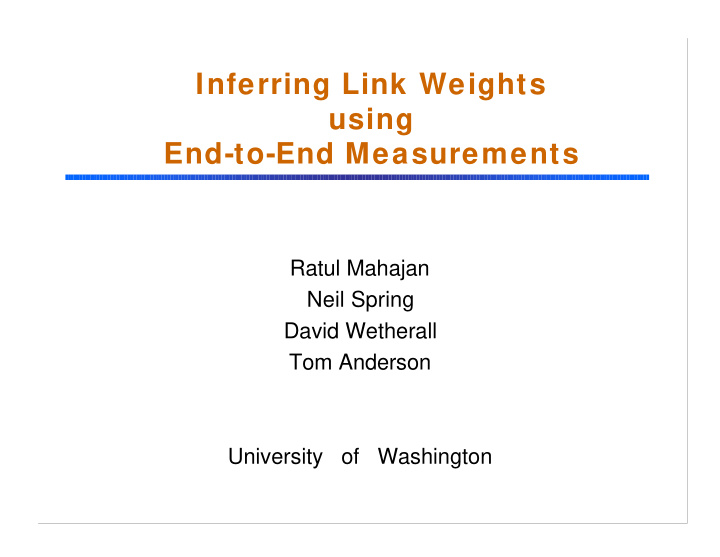



Inferring Link Weights using End-to-End Measurements Ratul Mahajan Neil Spring David Wetherall Tom Anderson University of Washington
Motivation: topology � routing � Accurate and detailed ISP topologies are now available � But how to route over them? c f • Hop count and latency based models are poor g a d Which way t o g? b e � Obtain a link weight based routing model • Most common model (OSPF, IS-IS, RIP) • Disclaimer: these are not the real weights! � Also helpful in understanding intra-domain traffic engineering 2 ratul | imw | 02 inferring link weights
Problem definition, basic solution w cf � Keys to the solution c f • All chosen paths between a node-pair w ac w cg w fg have the same weight (ECMP) w ad w dg g • This weight is less than that of other a d w bd w de possible paths w ab w eg b e w be � A constraint-based solution 1. w ad + w dg = w ab + w be + w eg [ADG= ABEG] � Given: 2. w ad + w dg < w ac + w cg [ADG< ACG] • Map of a network w/ weighted shortest path 3. w ad + w dg < w ac + w cf + w fg [ADG< ACFG] routing 4. w ad + w dg < w ab + w bd + w dg [ADG< ABDG] • Routing – chosen paths 5. w ad + w dg < w ad + w de + w eg [ADG< ADEG] between node pairs 6. w ad + w dg < w ab + w bd + w de + w eg � Wanted: [ADG< ABDEG] • Weights that characterize routing 3 ratul | imw | 02 inferring link weights
Making it tractable � Example c f • CG is a chosen path • The following exists in the system � g w cg < w cf + w fg a d 1. w ad + w dg = w ab + w be + w eg b e 2. w ad + w dg < w ac + w cg 3. w ad + w dg < w ac + w cf + w fg � Problem: too many constraints 4. w ad + w dg < w ab + w bd + w dg • Exponential in number of nodes 5. w ad + w dg < w ad + w de + w eg � Solution: use knowledge of chosen 6. w ad + w dg < w ab + w bd + w de + w eg paths between other node-pairs to remove redundant constraints 4 ratul | imw | 02 inferring link weights
Hello, real w orld! Limitations of routing information gathered using traceroute � Problem: some observed paths are non-chosen paths • Due to transient events such as failures • Renders the constraint system inconsistent • Solution: use error variables, minimize the weighted sum of errors 1. w ad + w dg - e adg = w ab + w be + w eg - e abeg 2. w ad + w dg - e adg < w ac + w cg � Problem: all chosen paths between a node-pair may not be observed • Due to a small number of measurements between the node-pair • w ad + w dg - e adg < w ac + w cg (but ACG may also be a chosen path for a � g) • Solution: w ad + w dg - e adg < = w ac + w cg 5 ratul | imw | 02 inferring link weights
Evaluation � Dataset: backbone topologies collected by Rocketfuel • 600+ vantage points, 9-200K+ traceroutes • Telstra (au), Ebone, Tiscali (eu), Abovenet, Exodus, Sprint (us) � Compare the inferred weights with three alternate models • Hops: Minimum hop count path • Latency: Minimum latency (geographical) path • HopLat: Minimum latency minimum hop count path � Criteria 1. What fraction of all observed paths fit? 2. What fraction of dominant paths fit 3. What is the accuracy of multi-path prediction? 6 ratul | imw | 02 inferring link weights
Fraction of all paths that fit � Weights describe the routing well • Weights: 87-99% • Hops: 67-92% (best alternate metric) � Performance level of hops is misleading (2 slides away) 7 ratul | imw | 02 inferring link weights
Fraction of dominant paths that fit � Dominant path: most common path between a node-pair � Weights fit more dominant paths • Weights: 76-98% • Hops: 49-82% (best alternate metric) 8 ratul | imw | 02 inferring link weights
Accuracy of multi-path prediction � Classify routing characterization between a node-pair as one of • Full: all predicted paths were observed (accurate) • Partial: some predicted path was not observed (over prediction) • None: none of the predicted paths was observed � Hops tends to predict more paths as being the preferred paths • 4-20% node-pairs are partial, only 47-81% full � Weights: 84-99% full, 1-3% partial 9 ratul | imw | 02 inferring link weights
Conclusions � A novel constraint-based approach to approximate intra- domain link weights � The inferred weights characterize intra-domain routing better than hop count and latency based metrics • Good predictive power � Future work • Investigate the “realism” of our weights � Predict backup paths • Understand intra-domain traffic engineering policies • Study link weight changes and link failures 10 ratul | imw | 02 inferring link weights
Recommend
More recommend